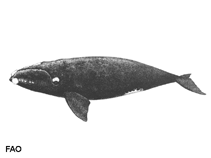Eubalaena glacialis (Müller, 1776)
North Atlantic right whale| Native range | All suitable habitat | Point map | Year 2050 |

|
| This map was computer-generated and has not yet been reviewed. |
| Eubalaena glacialis AquaMaps Data sources: GBIF OBIS |
Classification / Names Common names | Synonyms | CoL | ITIS | WoRMS
Mammalia | Cetartiodactyla | Balaenidae
Environment: milieu / climate zone / depth range / distribution range Ecology
Pelagic; oceanodromous (Ref. 75906); depth range 0 - 16 m (Ref. 116169). Temperate; 90°N - 90°S, 180°W - 180°E
Distribution Countries | FAO areas | Ecosystems | Occurrences | Introductions
North Atlantic: Balaena glacialis glacialis: Davis Strait, Denmark Strait, Norwegian Sea south to Massachusetts and the Bay of Biscay, south to Florida and the Golfo de Cintra, Western Sahara, Gulf of Mexico, Sea of Okhotsk, southern Bering Sea, northern Gulf of Alaska, south to the Sea of Japan, Pacific coast of northern Honshu and the coast of central California, Taiwan, Baja California Sur, Hawaiian Islands; Balaena glacialis australis: Subantarctic zone, between 35° to 40°S and 55° to 60°S, southern Brazil to northern Argentina, Tristan da Cunha, Namibia, southern Mozambique to Cape Province, St Paul Island, Southwest and southeast Australia, Kermadec Island, central Chile (Ref. 1522). Temperate, subpolar.
Length at first maturity / Size / Weight / Age
Maturity: Lm ?, range 1,250 - 1550 cm Max length : 1,800 cm TL male/unsexed; (Ref. 1394); max. published weight: 100.0 t (Ref. 1394)
Short description Morphology
Life cycle and mating behavior Maturity | Reproduction | Spawning | Eggs | Fecundity | Larvae
Main reference
References | Coordinator | Collaborators
Jefferson, T.A., S. Leatherwood and M.A. Webber 1993 FAO species Identification Guide: Marine Mammals of the World. Rome, FAO. 320 p. + 587 figures. (Ref. 1394)
IUCN Red List Status
(Ref. 130435: Version 2025-1)
CITES status (Ref. 108899)
CMS (Ref. 116361)
Threat to humans
Human uses
Fisheries: highly commercial
FAO - Fisheries: landings, species profile | FishSource | Sea Around Us
Tools
More information
Max. ages / sizes
Length-weight rel.
Length-length rel.
Length-frequencies
Mass conversion
Abundance
Internet sources
BHL | BOLD Systems | CISTI | DiscoverLife | FAO(Fisheries: species profile; publication : search) | Fishipedia | GenBank (genome, nucleotide) | GloBI | Gomexsi | Google Books | Google Scholar | Google | PubMed | Tree of Life | Wikipedia (Go, Search) | Zoological Record



